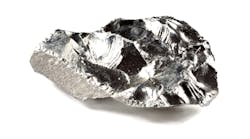Will New Gallium and Germanium Restrictions Impact the Tech Supply Chain?
Download this article in PDF format.
On Aug. 1, China put new restrictions in place for the export of two minerals that the semiconductor manufacturing industry relies on: gallium and germanium. A chemical element, gallium is a soft, silvery-white metal that melts at the lowest melting point of any metal in the periodic table. As a semiconductor that can conduct electricity under certain conditions, gallium is frequently used to make lasers, transistors and other electronic devices.
Also a semiconductor, germanium is a lustrous, hard-brittle metalloid that’s used to manufacture infrared devices, solar cells, optical fibers and other products. Like gallium it has a silvery-white appearance, and is also used as a contrast agent in magnetic resonance imaging (MRI) scans.
Roughly 80% of the world’s gallium is produced in China, according to the CRM Alliance. China is also responsible for around 60% of the world’s total germanium production. The remaining production of germanium comes from Canada, Finland, Russia and the U.S. For these and other reasons, any limit on Chinese exports of either—or both—of these metals is of concern to the global electronics sector.
What the New Rules Say
Under the new controls, the BBC says that special licenses are needed to export gallium and germanium from the world’s second largest economy. Along with the U.S., both Japan and the Netherlands—which is home to key chip equipment maker ASML—have imposed chip technology export restrictions on China.
“The timing of this announcement from China is not coincidental, given chip export restrictions announced by the Netherlands among others,” BMO Capital Markets’ Colin Hamilton told the BBC. "Quite simply, if you won’t give us chips, we won’t give you the materials to make those chips.”
As the world’s top supplier of the two minor metals used to make semiconductors, China announced the new restrictions on exports of eight gallium and six germanium products in early July, citing national security reasons, according to Reuters. Now, exporters of these products need to apply for export licenses for dual-use items and technologies (i.e., those with potential military as well as civil applications).
“With a stronghold over the global production of gallium (94%) and germanium (around 60%), China's announcement of these restrictions in early July led to nearly a 20% price hike for gallium in the U.S and Europe,” Anton Shilov writes in “China Imposes New Export Restrictions on Gallium and Germanium.”
“While the rules are said to be in the interests of China’s national security, many see them as a retaliation to curbs on China’s high-tech sector,” Shilov continues, noting that the production of CPUs, GPUs and memory isn’t likely to be impacted by the new rules. However, he adds, it’s “worth noting that GaN (gallium nitride) and GaAs (gallium arsenide) are integral to power chips, radio frequency amplifiers, LEDs and numerous other applications.”
Opening New Doors
Neither gallium nor germanium are “exceptionally rare,” and both metals are usually acquired as byproducts of other mining operations. However, China’s dominance in their exports is due to its cheap refinement process, which made “extracting these metals in other regions financially unviable,” Reuters adds. “China’s new restrictions could cause an initial increase in prices and potential disruptions in supplies and component production.”
Although China is the leading exporter of gallium and germanium, there are substitutes for the materials in the production of components like computer chips, according to the BBC. For example, it says there are also active mining and processing facilities located outside of China.
On a positive note, these new limitations set forth by China could encourage organizations outside of the country to start mining these metals, possibly threatening China's market dominance. For example, Reuters says the Pentagon recently declared plans to recover gallium from waste electronics.








